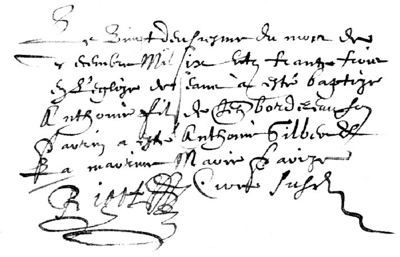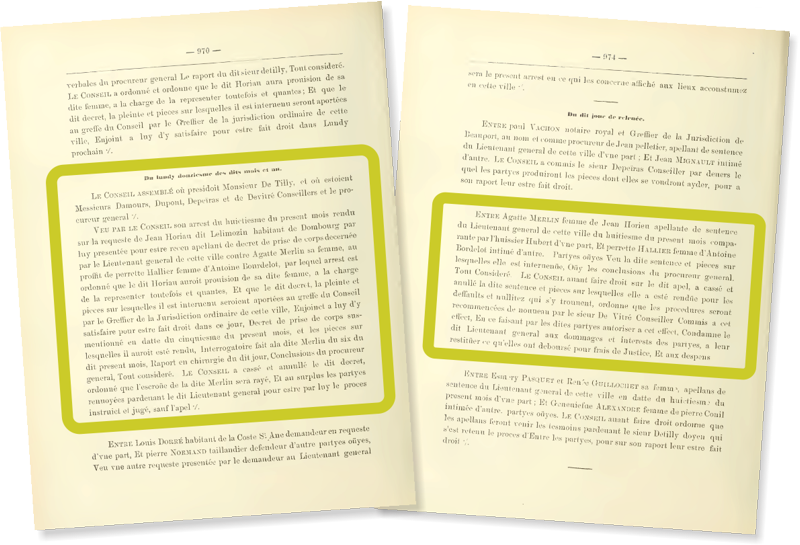Perrette Halier

Arrived: June 30, 1669
Age at arrival: 18
Births: 2 / 2 surviving
Widowed: no
Age at death: 49
If you seek mystery in the stories behind our 18 Filles, you might find it in Perrette Halier, born about 1651 in Égly, Île-de-France. She was the fourth Filles du Roi ancestor to arrive among the large contingent of French women that also brought Chanfrain, Doribeau, and Godequin on this date.
Records in France reveal that at age 13 or 14 Perrette was placed in the care of Jean Marineau, a tailor, who had a three-year contract with her parents to house her and teach her his trade, training for which they paid 120 pounds. There is no further information that elaborates on this part of her young life. We only know that by her 18th birthday in 1669 she had been recruited and was registered in the king’s program to come to New France. With this approval she would have received the cash disbursement that paid for the long passage by horse-drawn carriage to Dieppe from Égly, or perhaps from nearby Paris. There she boarded Le Saint-Jean-Baptiste for Canada, bringing her dowry stated to be worth about 350 livres. No doubt she was full of trepidation about the new life she had chosen.
Perrette Halier arrived at Québec City among 149 other Filles du Roi who survived malnutrition and the dreadful conditions that were an inherent reality in making a 17th century trans-Atlantic crossing.

Antoine Bordeleau baptismal certificate
Antoine Bordeleau dit Laforest was the son of Jean Bordeleau and Marie Villain of La Rochelle in Aunis province in France. He had joined the military and arrived in Québec to defend settlers against the Iroquois, but when the regiment dissolved in 1668, he chose to remain. Historical records confirm that on March 25, 1669, just a few months before he met Perrette, he was in Neuville, Québec.
Over the three months that Perrette stayed in the care of the Ursulines, she was probably taught housekeeping, sewing, cooking, and survival skills for a future in the tough environment of New France. There is an explanation why she did not accept a marriage proposal within the first month when so many of her peers did, but we can only wonder what it might have been. Women were a precious commodity where men outnumbered them 6 to 1. Did she simply not find one suitable?
Ultimately Perrette agreed to marry Antoine Bordeleau at Québec City. The date is reported ambiguously as either September 29 or October 15, but it's possible that the earlier date was the contractual date and the later date was their wedding ceremony. In either case, she received the additional dowry promised by the king of 50 livres in kind to start her new life.
Perrette and Antoine established their home in Neuville and had just two children. It was their second child, Marie-Louise, born August 15, 1676, who led her mother’s genealogical trail to Grandmother Clarice Bergeron.
- 1695 Marie-Louise
Bordeleau m. Louis Croteau » Marie*
- 1732 Marie Croteau
m. Joseph Bergeron » Jacques
- 1764 Jacques Bergeron
m. Françoise Rondeau » Pierre
- 1792 Pierre Bergeron
m. Charlotte Dussault » Antoine
- 1826 Antoine Bergeron
m. Louise Genest » Alfred
- 1847 Alfred Bergeron
m. Lucie-Marie Bibeau » Clarice
- 1870 Clarice Bergeron
m. Lazare Côté
- 1695 Marie-Louise Bordeleau m. Louis Croteau » Marie*
- 1732 Marie Croteau m. Joseph Bergeron » Jacques
- 1764 Jacques Bergeron m. Françoise Rondeau » Pierre
- 1792 Pierre Bergeron m. Charlotte Dussault » Antoine
- 1826 Antoine Bergeron m. Louise Genest » Alfred
- 1847 Alfred Bergeron m. Lucie-Marie Bibeau » Clarice
- 1870 Clarice Bergeron m. Lazare Côté
* The Bordeleau-Croteau marriage appeared above under Jeanne Godequin since a child of one Fille du Roi who was our ancestor married a child of another ancestral Fille du Roi.
What exactly happened during the six years leading to 1675 will never be known, but it is clear that Perrette was involved in a criminal case — apparently as a victim — involving another Fille du Roi, Agathe Merlin. (Merlin landed in 1670, one year later than Perrette. She was unrelated to us.) Agathe Merlin was sentenced to prison, but no records have been uncovered to explain her crime and how it precisely involved Perrette.
Interestingly there is a biography published of Antoine Forestier, a surgeon employed by the hospital Hôtel-Dieu. It states that as a medical-legal expert, he was frequently required to conduct physical and medical examinations of persons who reported physical beatings to the Conseil Souverain, the “Sovereign Council”, the earliest courts in New France. The biography also states that his reports led to criminal trials against women, often initiated by complaints of the women who were victimized. The source falls short of naming his patients or specifically that Perrette was beaten by Merlin, but it appears highly possible, and even most probable.

Excerpts from Jugements et Délibérations du Conseil Souverain de la Nouvelle-France, Vol. I, the historic rulings of Canada's first court.
Merlin’s sentence to prison by the Prévôté de Québec was appealed, much to Perrette’s displeasure, since the court records indicate that Perrette tried unsuccessfully to intervene in any changes to the original judgment. Merlin was released prematurely from prison in 1675 and placed in her husband’s care on the grounds that she was pregnant. It appears that the Conseil Souverain called for a retrial, but Perrette’s name does not reappear in the judicial annals, thus suggesting that the matter was closed or stayed.
The 1681 official census for Perrette’s and Antoine’s household reads as follows, directly translated from French:
“Antoine Bordeleau 45; Perrette Halier, his wife, 30; children: Antoine 8, Marie 5; 1 rifle; 1 horned beast; 20 arpents in value. They live in the lordship of Dombour, (Neuville), Canada.”
